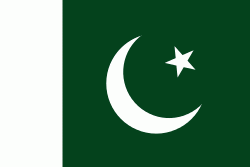Lahore Division (Lahore Division)
Lahore Division is an administrative division of Punjab Province, Pakistan. It comprises four Districts - Kasur, Lahore, Nankana Sahib and Sheikhupura. The Lahore Division is commanded by a Commissioner to manage the division. Under the Commissioner there are four Additional Commissioners. For each district there is a Deputy Commissioner. Under the reforms of 2000, this tier of government was abolished, but in 2008 divisions were restored.
Lahore Division was originally an administrative division of the Punjab Province of British India. It extended along the right bank of the Sutlej River from the Himalaya to Multan, and comprised the six districts of Sialkot, Gujranwala, Lahore, Amritsar, Gurdaspur and Gujrat. The total area of the division was 17154 sqmi and the population according to the 1901 census of India was 5,598,463. The commissioner for the division also exercised political control over the hill state of Chamba. The Commissioner's headquarters were at Lahore and Dalhousie.The total population of the Division increased from 4,696,636 in 1881 to 5,321,535 in 1891, and 5,598,463 in 1901. The total area was 17154 sqmi, and the density of population was 326 persons per square mile, compared with 208 for British territory in the Province as a whole. In 1901 Muslims numbered 3,332,175, or 60 percent of the total; while other religions included Hindus, 1,567,402; Sikhs, 661,320; Jains, 5,5,07; Buddhists, 6; Parsis, 228; and Christians, 31,815, of whom 25,248 were natives.
The division contained six districts:
Gurdaspur included a few square miles of mountainous country, enclosing the hill station of Dalhousie (highest, point, 7,687 feet) ; but otherwise the Division was flat. It contained 9,869 villages and 41 towns, of which the largest are Lahore (population, 202,964, including cantonment), Amristar(162,429), Sialkot (57,956), Gujranwala (29,224), Batala (27,365), and Gujrat (22,022). In commercial importance Lahore and Amritsar dwarfed all other towns in the Division, but Sialkot and Batala were considerably more than local centres. Besides the administrative charge of six British Districts, the Commissioner of Lahore had political control over the Native State of Chamba, which had an area of 3216 sqmi and a population (1901) of 127,834.
Lahore Division was originally an administrative division of the Punjab Province of British India. It extended along the right bank of the Sutlej River from the Himalaya to Multan, and comprised the six districts of Sialkot, Gujranwala, Lahore, Amritsar, Gurdaspur and Gujrat. The total area of the division was 17154 sqmi and the population according to the 1901 census of India was 5,598,463. The commissioner for the division also exercised political control over the hill state of Chamba. The Commissioner's headquarters were at Lahore and Dalhousie.The total population of the Division increased from 4,696,636 in 1881 to 5,321,535 in 1891, and 5,598,463 in 1901. The total area was 17154 sqmi, and the density of population was 326 persons per square mile, compared with 208 for British territory in the Province as a whole. In 1901 Muslims numbered 3,332,175, or 60 percent of the total; while other religions included Hindus, 1,567,402; Sikhs, 661,320; Jains, 5,5,07; Buddhists, 6; Parsis, 228; and Christians, 31,815, of whom 25,248 were natives.
The division contained six districts:
Gurdaspur included a few square miles of mountainous country, enclosing the hill station of Dalhousie (highest, point, 7,687 feet) ; but otherwise the Division was flat. It contained 9,869 villages and 41 towns, of which the largest are Lahore (population, 202,964, including cantonment), Amristar(162,429), Sialkot (57,956), Gujranwala (29,224), Batala (27,365), and Gujrat (22,022). In commercial importance Lahore and Amritsar dwarfed all other towns in the Division, but Sialkot and Batala were considerably more than local centres. Besides the administrative charge of six British Districts, the Commissioner of Lahore had political control over the Native State of Chamba, which had an area of 3216 sqmi and a population (1901) of 127,834.
Map - Lahore Division (Lahore Division)
Map
Country - Pakistan
 |
 |
| Flag of Pakistan | |
Pakistan is the site of several ancient cultures, including the 8,500-year-old Neolithic site of Mehrgarh in Balochistan, the Indus Valley civilisation of the Bronze Age, the most extensive of the civilisations of the Afro-Eurasia, and the ancient Gandhara civilization. The region that comprises the modern state of Pakistan was the realm of multiple empires and dynasties, including the Achaemenid; briefly that of Alexander the Great; the Seleucid, the Maurya, the Kushan, the Gupta; the Umayyad Caliphate in its southern regions, the Hindu Shahis, the Ghaznavids, the Delhi Sultanate, the Mughals, the Durranis, the Omani Empire, the Sikh Empire, British East India Company rule, and most recently, the British Indian Empire from 1858 to 1947.
Currency / Language
| ISO | Currency | Symbol | Significant figures |
|---|---|---|---|
| PKR | Pakistani rupee | ₨ | 2 |
| ISO | Language |
|---|---|
| EN | English language |
| PA | Panjabi language |
| PS | Pashto language |
| SD | Sindhi language |
| UR | Urdu |















